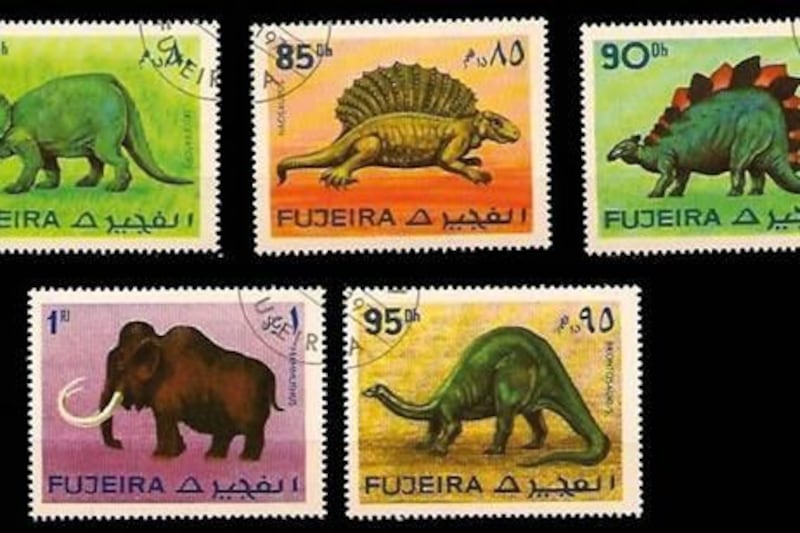SHARJAH // If stamps are visual records of a nation's history, then penguins from Umm al Qaiwain, space ships and astronauts from Dubai, and various illustrations of Jesus and the Virgin Mary from Sharjah paint an interesting portrait of the UAE.
Some of the oddest stamps issued throughout the history of the country, before and after its unification, are explained in the book Tarekh Tawabee al Emirate, the first stamp history book of its kind to be published in the UAE. Released earlier this month in Arabic, an English version is due to follow within three months.
"It was very difficult putting it all together, as there was no point of reference, and some stamps have been lost forever," said the book's author, Moutaz Mohammed Othman.
In a letter to the author, Dr Sheikh Sultan bin Mohammed, Ruler of Sharjah, hailed the book as an important "historic tool".
"It documents the history of stamps in the UAE and is a great tool for collectors of this fun hobby," he wrote.
An avid stamp collector for more than 27 years, Mr Othman has made it his life mission to find the story behind the various stamps issued over the years.
"A stamp is more than art work," he said. "It is a story and often a rare one."
The 41-year-old businessman is an active member of the Emirates Philatelic Association, which has grown to more than 250 members since it was established by ministerial decree in 1996. Postage has a much longer history in the Emirates, however, dating back to 1909, when the Indian Branch Post Office opened in Dubai. In 1932, the first official stamped letter was sent out from Dubai, via the Sharjah airport.
"Before the union, it was more chaotic, with each emirate printing its own sets of stamps by commissioning them abroad, like in UK or US," said Mr Othman. "And so often the stamps had nothing to do with the actual emirate and were quite irrelevant to local culture."
That would explain the images of ancient Greek and Roman statues, religious figures and biblical images, such as Adam and Eve, and depictions of the latest advances in technology, including space ships and metros that graced local stamps.
Flowers and insects were frequently used as images. And while those older stamps included indigenous creatures, such as gazelles, sometimes they featured other animals, including the Russian dog Laika, the first living creature sent to space in 1957.
"After they issued stamps of birds and animals of all kinds, like all breeds of cats and dogs, and wild elephants and panthers, they turned to international events and figures, as not much was happening here in the UAE before it united," Mr Othman said.
The 35th US president, John F Kennedy, was such a popular figure on local stamps that each of the trucial states printing their own version of JFK. In 1964, the year following his assassination, Sharjah printed stamps featuring JFK with the Statue of Liberty.
Another series featured the politician with his family, "Ajman" printed clearly across the bottom. Other figures found on 1960s local stamps included the leader of the US civil rights movement, Martin Luther King Jr, and the "father of India", Mahatma Gandhi. Others that were used during the era were too inappropriate to be included in the book.
"I had to omit a large collection of pre-union local stamps, especially nude ones, like a popular one of Marilyn Monroe, as I didn't want to offend anyone," said Mr Othman.
The 375-page book is broken down into two sections, before and after the union, with each of the emirates having its own collection of rare and odd stamps in the appendix. When the UAE formed in 1971, its stamps also changed dramatically.
"After the union, the stamps were more uniform and controlled, with careful images of the rulers and various national events," said Mr Othman.
Under the UAE appendix, Mr Othman included a collection from 1980 that was pulled immediately from circulation: it had an illustration of an open Koran on the stamp, and others with the wrong dates and names on it. One stamp misspelled the town of Al Dhaid, as "Al Lazez," which means delicious.
Mr Othman plans to publish a separate book on the errors, "as there are so many of them".
Stamp collecting has been enjoying a surge in popularity of late. And Mr Othman believes the general public, and not just stamp enthusiasts, will buy his book.
"People think stamps are boring, and stamp collectors are geeky," he said. "But honestly, a stamp that once cost less than a dirham is now worth thousands of dirhams. What is so geeky about such a lucrative hobby?"
Spaceships
With space travel big in the international news, Dubai decided to issue a wide collection of "space stamps" in 1964 in honour of astronauts. Dubai was one of the first emirates to have a post office, and being an important port on the trade routes, its stamps were among the most diverse. Costs were about 2 rupees.
Dinosaurs
Fujairah used to issue extensive collections of stamps on animals, birds and insects, including mosquitoes and butterflies. Dinosaurs and mammoths were also popular, issued up until 1972. Even after the unification, some animal collections continued to be issued due to popularity. Costs were all about 1 riyal, or less.
Penguins
Umm al Qaiwain did not issue as many stamps as other emirates, but it had distinctive ones, including some featuring penguins. Costs were about 1 riyal.






